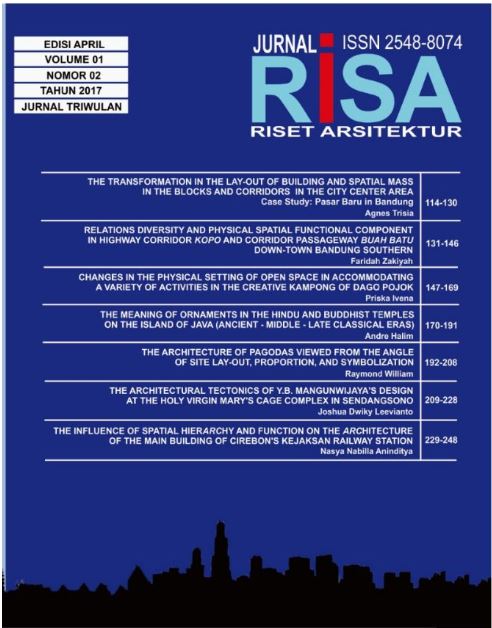THE TRANSFORMATION IN THE LAY-OUT OF BUILDING AND SPATIAL MASS IN THE BLOCKS AND CORRIDORS IN THE CITY CENTER AREA CASE STUDY: PASAR BARU IN BANDUNG
DOI:
https://doi.org/10.26593/risa.v1i02.2388.114-130Abstract
Abstract - The overly rapid development of commercial functions has changed the lay-out (massing) of Pasar Baru and its environs, along with the horizontal and vertical expansion of buildings, causing a typo-morphological transformation, leading to problems with the lay-out in terms of scale, façade, orientation, and building height. This research study is followed by a description of this lay-out and its impact on the blocks and corridors of Jalan Otto Iskandar Dinata (Otista) by way of the qualitative-descriptive survey method, complemented by study of the relevant background literature, and a discussion of the typo-morphological transformation of Jalan Otista. The changes have impacted the blocks and corridors. The former came in the shape of the residential pockets being wedged together, a change of circulation in these pockets, disorientation of the block mass, and asymmetry or discrepancy observed in the building scale. The latter took the shape of changes in the building façades that tend to be heterogeneous, assymetry or discrepancy in the building scale, the interrupted arcade and non-defined entrance doors to alleys.
The conclusion shows that this area displays a typo-morphology of building façades that is relatively heterogeneous. This area will experience vertical building with a larger building mass of blocks that is relatively larger in volume. In turn, this will cause the residential pockets within the blocks to disappear although some of these are bound to survive. This study may provide useful input for the municipal government in anticipating and overcoming the problems surrounding the spatial lay-out and urban planning of a developing city.
Keywords: transformation, mass lay-out, block, corridor












